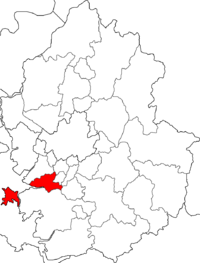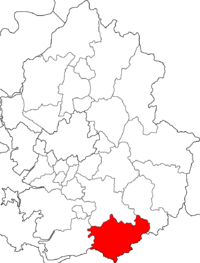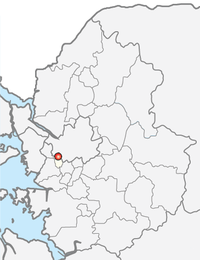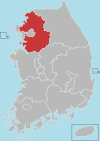Korea has had administrative districts that can be considered provinces since the 7th century. These divisions were initially called ju in Unified Silla and Later Baekje, and there were nine in total. After Goryeo conquered these states in the 10th century, twelve divisions called mok were established, although they were reorganized into ten do in the 11th century.

Gimpo is a city in Gyeonggi Province, South Korea. It borders Incheon, with which it shares the South Korean side of the Han River estuary, as well as Seoul and the lesser cities of Paju and Goyang. North Korea is across the Han River. The current mayor is Jeong Hayoung. The city's population of more than 300,000 is made up of more than 71,000 households.
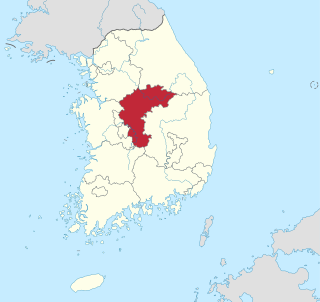
North Chungcheong Province, also known as Chungbuk, is a province of South Korea. North Chungcheong has a population of 1,578,934 (2014) and has a geographic area of 7,433 km2 (2,870 sq mi) located in the Hoseo region in the south-center of the Korean Peninsula. North Chungcheong borders the provinces of Gyeonggi and Gangwon to the north, North Gyeongsang to the east, North Jeolla to the south and South Chungcheong, Sejong Special Autonomous City and Daejeon Metropolitan City to the west.

Gyeonggi Province is the most populous province in South Korea.

Hwanghae Province was one of the Eight Provinces of Korea during the Joseon era. Hwanghae was located in the northwest of Korea. The provincial capital was Haeju. The regional name for the province was Haeseo.
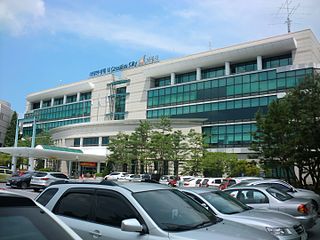
Hwaseong is a city in Gyeonggi Province, South Korea. It has the largest area of farmland of any city or county in Gyeonggi Province. Seoul Subway Line 1 passes through Hwaseong, stopping at Byeongjeom Station. Suin Bundang Line also passes through Hwaseong, stopping at Eocheon Station.
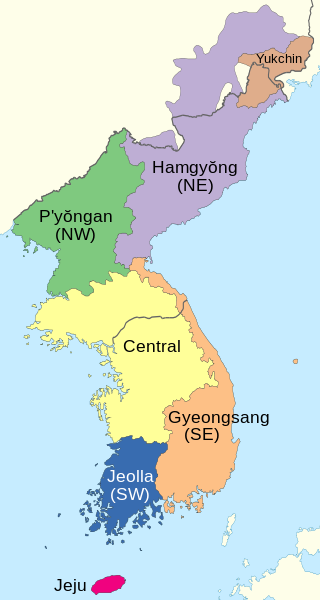
A number of Korean dialects are spoken on the Korean Peninsula. The peninsula is very mountainous and each dialect's "territory" corresponds closely to the natural boundaries between different geographical regions of Korea. Most of the dialects are named for one of the traditional Eight Provinces of Korea. Two are sufficiently distinct from the others to be considered separate languages, the Jeju and the Yukjin languages.

Gwangju is a city in Gyeonggi Province, South Korea, a suburb southeast of Seoul. The city is not to be confused with the much larger Gwangju, former capital of South Jeolla Province, or Guangzhou, the city of Guangdong, China in Hanja.

Anseong is a city in Gyeonggi Province, South Korea, 80 kilometres (50 mi) south of Seoul. Its geographical location is 37°0′N127°16′E.

Gwacheon is a city in Gyeonggi Province, South Korea. It lies close to Seoul in the heart of the Seoul National Capital Area, and also lies just east of Anyang. Seoul Subway Line 4 passes through the city.

Pocheon (Korean: 포천; Korean pronunciation:[pʰo.tɕʰʌn]) is an inland city in northeast Gyeonggi Province, South Korea. It covers 826.48 km (513.55 mi)2 with a population of 160,176 people, according to the 2008 census. Pocheon lies between Seoul and the mountainous northwestern areas of Gangwon Province. The city borders Yeoncheon county, with the cities of Dongducheon and Yangju to the west, along with Uijeongbu, and Namyangju of Gyeonggi province to the south. It also borders Hwacheon county of Gangwon province on its eastern border and Cheorwon is to the north. Alongside the adjoining Gapyeong, Pocheon consists of the highest mountainous areas in Gyeonggi province. The current city of Pocheon was created after Pocheon-hyeon and Yeongpyeong counties were merged. The north part of the city used to be part of Yeongpyeong county while the south used to be part of Pocheon-hyeon.

Seongnam is the fourth largest city in South Korea's Gyeonggi Province after Suwon and the 10th largest city in the country. Its population is approximately one million. It consists of three administrative districts: Bundang District, Jungwon District, and Sujeong District.

Siheung is a city in Gyeonggi Province, South Korea. The city has a population of 511,807 people, where 508,646 are residents out of 218,846 households as of August 2021. Siheung acquired its current administrative structure on January 1, 1989, the former Siheung County was divided into the cities of Siheung, Gunpo, and Uiwang. At the time, Siheung had a population of only 93,000. This number more than tripled in the following decade as massive suburban apartment complexes were developed. Siheung's current area formerly belonged to Incheon and Ansan before 1914.

Uijeongbu is a city in Gyeonggi Province, South Korea.

Provinces are one of the first-level divisions within South Korea. There are 9 provinces in South Korea: North Chungcheong, South Chungcheong, Gangwon State, Gyeonggi, North Gyeongsang, South Gyeongsang, North Jeolla Province, South Jeolla, and Jeju Special Self-Governing Province.
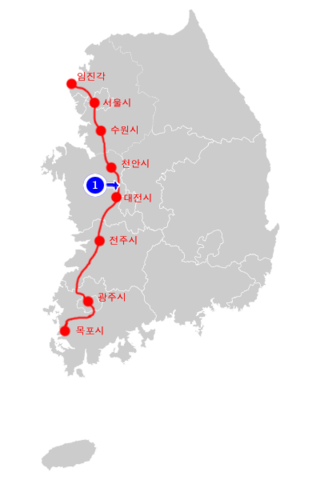
National Route 1(Korean: 국도 제1호선; RR: Gukdo Je Il Hoseon) is a national highway in South Korea. It connects Mokpo, South Jeolla Province with the city of Paju in Gyeonggi-do. Before the division of the Korean peninsula, the highway ran until Sinuiju, North P'yongan Province, in present-day North Korea.

The Seoul Metropolitan Area or Gyeonggi region, is the metropolitan area of Seoul, Incheon, and Gyeonggi Province, located in north-western South Korea. Its population of 26 million is ranked as the fourth-largest metropolitan area in the world. Its area is about 12,685 km2 (4,898 sq mi). It forms the cultural, commercial, financial, industrial, and residential center of South Korea. The largest city is Seoul, with a population of approximately 10 million people, followed by Incheon, with three million inhabitants.
National Route 43 is a national highway in South Korea connecting Sejong City to Kosong County. It was established on 31 August 1971.

Gyeonggi, alternatively spelled Kyŏnggi or Kyunggi, is a region of the Korean Peninsula that has historically occupied the west-central region of Korea. In modern times, the region hosts South Korea's Gyeonggi Province and Incheon Metropolitan City, and North Korea's Kaesong Industrial Region, and Changpung, and Ch'ŏrwŏn counties.
